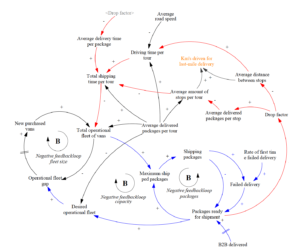E-commerce influences the logistic sector in different ways. The growth of e-commerce leads to more use of transportation but also results in more logistic efficiency of this transportation. The amount of consumers increases and also the demand per consumer increases. This results in shorter distances between the stops and more packages delivered per stop, which increases the efficiency of deliveries.
Annette Heinen, a student at Dutch TU Delft, looked at the impact of growing e-commerce on last-mile trips and kilometers. This efficiency will however not continue indefinitely and the negative impacts on the environment and mobility will grow continuously.
The use of pick-up points is based on the same parameters providing the logistic efficiencies and are a strong long term solution to the growth. Furthermore, using pick-up points increases the rate of successful first time delivery, this results in less needed shipping capacity. Passenger transport is needed to pick-up the package, this effect is not incorporated.
Strategies are developed to assess two policy strategies, the use of (unmanned) pick-up points and the use of light electric freight vehicles (LEFV). The use of LEFV’s reduces the amount of emitted pollution and the amount of road traffic movements. However more vehicles are needed and the traffic movements will only be moved to bicycle lanes. Both strategies are realistic and some logistic service providers are already implementing the strategies.
The government can use several instruments on levers within the last-mile delivery system. Delivery van capacity, first-time hit rate, and the number of packages delivered at once per stop are the most influential levers within this research scope. This means that the government should look into the available instruments and their influence on these parameters.
A campaign to create awareness among citizens to stay home when they expect a package, could for example help to increase the first-time hit rate. Using (unmanned) pick-up points leads to less needed shipping capacity, due to the impact on the first time hit rate and thus less impact on the environment and mobility. The usage of LEFV’s complementary to the use of conventional delivery vans results in less pollution.
Source: TU Delft

